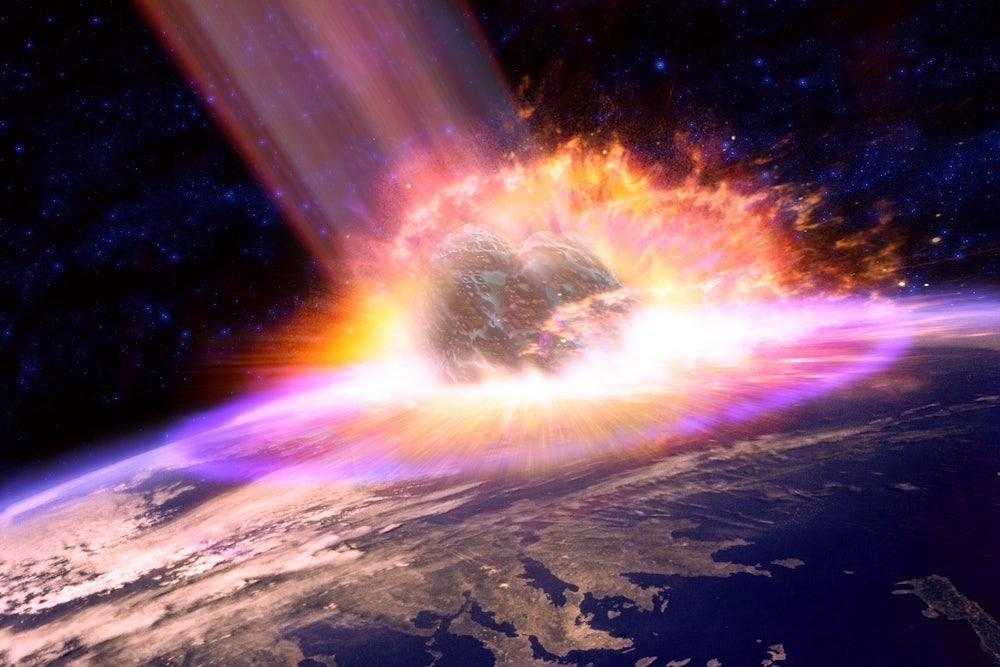When I was younger, we watched a lot of movies about the end of the world. Deep Impact and Armageddon threw space rocks at us. Air, water, and the earth itself turned evil in Dante’s Peak, Twister, and Volcano. Fantastical artworks are a type of escapism, and the way that we choose to escape reality is defined by that reality. At the time of 1998’s Armageddon, we were discussing the end of history. The world was stable and the future glowed, for the West; our supremacy was the condition of world peace. We indulged in visions of disaster because they could only happen in a parallel and near-unimaginable universe. From our safe perch at the top of a whole millennium, we enjoyed imagining an earth shaken to bits.
Seventeen years into the new century, disaster feels too real for that. War, climate change, and the return of fascist politics to the United States and Europe have all shown that the certainties of the 1990s were not certainties at all. How do we escape, now? In 2017 the monsters of our nightmares stepped into the daylight, and in response we turned to a new version of the real.
In April 2017, Instagram hit 700 million users. In September, 800 million. Of those, 500 million use it every day, including everybody I know. Time spent watching video on the app has increased by about 80 percent this year. The number of its advertisers has doubled since March. Those numbers record in monetizable facts how hard we fell into other people’s lives in 2017.
Instagram’s voracious success is distinct from Twitter’s or Facebook’s (although of course Facebook owns everything you do on Instagram). There’s very little that’s conversational about Instagram. Comments don’t thread easily, nor is the DM system particularly intuitive. Instead, Instagram is where we transmit images into the void, then analyze the data that comes back. By 2015, the undeniable correlation between image and user response had already given rise to such tacky demi-worlds as influencer marketing and “fine art Instagram,” where people post artworks to show that they have been in front of them.
We start with our own. Friends and family populate our feeds. We scroll, and see through our loved ones’ eyes. Maybe we also follow Cardi B and Beyoncé, or some aspirational fitness obsessive or body positive role model or brilliant drag performer. But these people are just the bait on a hook.
The feed runs out. But right by it, so close, lies the “explore” button. How recently hitting the “explore” button seemed ridiculous! Perhaps, like me, you also do Instagram while curled on your side in bed, frozen as if by a spell. Get up, a voice says, you’re going to be late. But we can’t. And what do we find there? A friend of a friend of a friend. An intriguing hashtag yielding strange results. A new joke that feels like something fizzing in the brain. An hour goes by like a minute. We cannot seem to move our bodies but universes are opening out on the screen.
Jumping down the Instagram rabbithole is partly about exploring all the different lives there are to live, and so refusing to live our own. Sometimes we are mocking or morbidly fascinated by those we stalk, but mostly we are in these other people’s accounts just to see.
Some people I know are fascinated by the most banal people you can imagine. The lust for the details of their lives is both forensic and ghoulish. It’s like they want to pick up Sandra from Montana and bite into her. Some people are into celebrities in an old-school way, a People magazine way. There’s something reassuring about celebrity Instagram world. They’re up to what they’ve always been up to—being rich and stupid.
Of all Instagram’s new celebrities, I am most happy for the makeup and hair and performance artists. They now have a place to make their craft, the altering of the human appearance, central. (Sometimes makeup artists only do one side of their face, to make clear their terrifying power.) And no matter how strange the artist’s style, or how bizarre the lifestyle Instagrammed, everything takes on a sheen of normalcy. I follow a girl who keeps multiple foxes in her house. Life happens every day, for everybody. The everyday becomes more remarkable on Instagram, as it takes on a form and beauty of its own.
In 2017, my voyeurism was not limited to Instagram. I also watched a lot of YouTube videos about real-life disaster: near-misses, enormous waves, amazing encounters with killer animals. The footage that GoPros and dashboard cams have recorded in the last few years is mindblowing. In one compilation of near-death experiences, a NASCAR crash sends a car bouncing wildly through a crowd, somehow just missing every single body. I watched hours of the 2011 tsunami, in which an ocean behaves impossibly. I watched the GoPro video of a kayaker who suddenly realizes he is beside an enormous shark. The creature is double the size of his own flimsy vessel and might at any second decide to eat him, absentmindedly. There is something about these brushes with danger that feels reassuring. Each clip is documentary-style, with shaky camera and unrehearsed voiceover. But their extremity connects back to Armageddon, Dante’s Peak. They close a certain loop.
The developments of this year have destabilized the categories of horror, fantasy, fiction, disaster, dailiness, and truth. In 2017 a lot of people wake up and refuse to believe that any of this is happening. But the dawn arrives every day, the freakiest Instagram is still posting, the casual art of everyday life continues to paint itself. Daily persistence has its own beauty. Eventually we get up off the bed.
